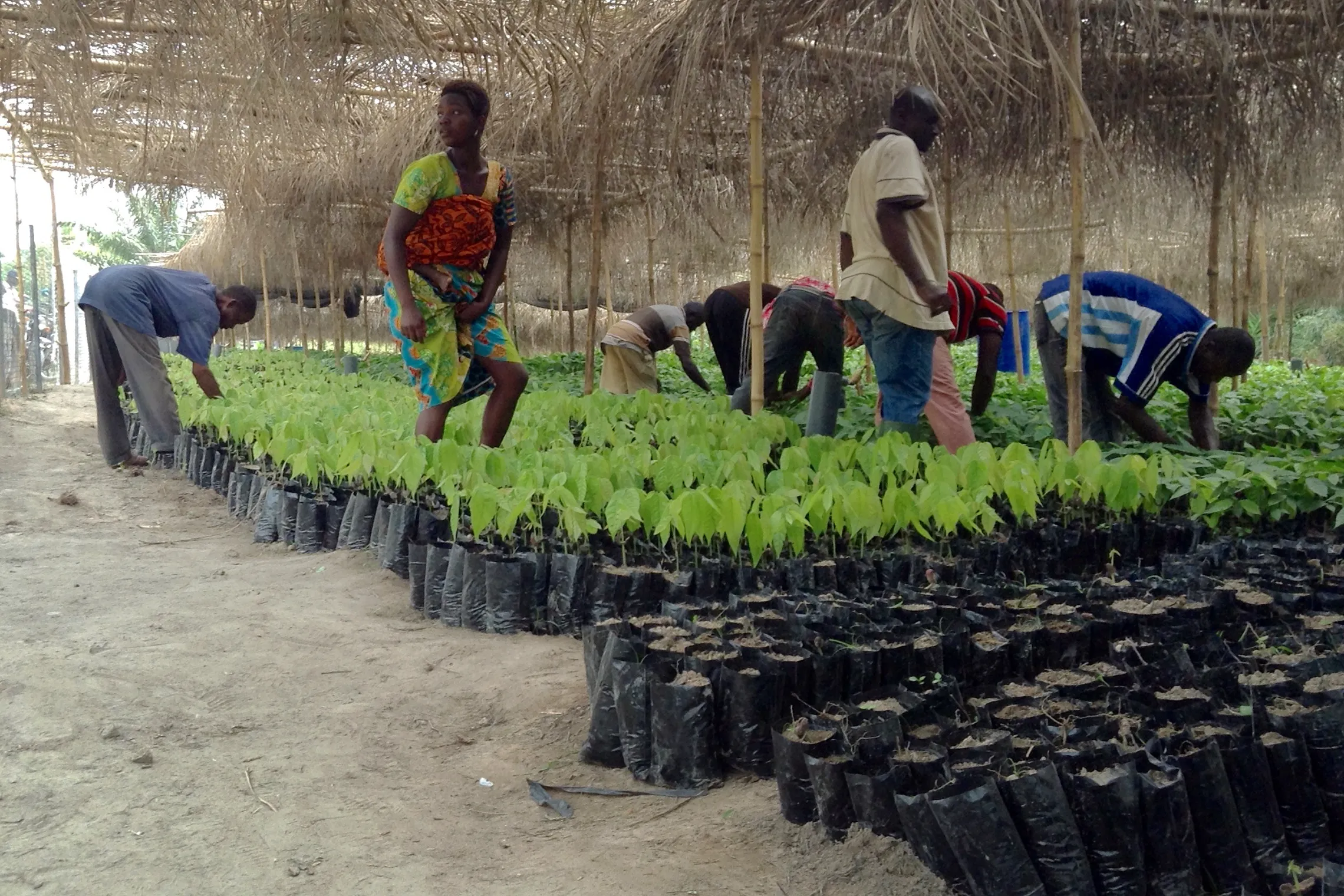Nursing future production – towards shaded cocoa farms

A lone SNV signboard somewhere along a dusty road at the edge of a once impenetrable Ghanaian forest, now shrunken to this tiny fertile dot in the landscape, surrounded by cocoa farms. Meet Bia North Forest Reserve.
What's happening here? As cocoa trees in Ghana are generally old and often in poor health, their yields are diminishing. Add climate change, which is causing drought in this once wet rainforest area and farmers end up with dwindling harvests. Once upon a time the sun was a useful ingredient to stimulate cocoa growth, but without adequate levels of rainfall the relentless sun becomes their enemy. Smallholder cocoa farmers often live near subsistence level and they just cannot overcome these additional struggles. In an attempt to compensate for the loss, they add land to their farms. But this land is no longer in abundance, so they encroach upon the remaining patches of forest and chop down the native trees to plant more cocoa.
At the edge of the forest SNV project advisor Charles Brefo Nimo explains what happens.
The basic idea of the "From full sun to shaded cocoa forestry" project, co-developed with the German Federal Ministry of Environment, Nature Conservation, Building and Nuclear Safety (BMUB) is to convince farmers to cut their old unproductive cocoa trees and nurture improved seedlings instead.
These seedlings need to grow under the protective branches of trees, providing them with shade and water, so they may reach maturity. But as there are no trees left, plantain will do.

A cocoa tree nursery
The idea of the project is simple; if farmers can earn a decent living off their land, they no longer need to encroach upon the forest. This is an assumption in need of testing, and that’s exactly what SNV is doing in Ghana’s High Forest Zone. Intuitively it makes sense; one can't expect people to protect the forest on an empty stomach.
"Then just take these seedlings and hand them out to the farmers," you may think. And for sure, SNV has established large nurseries, trained farmers to take care of them and prepare their land for the new seedlings. But there is more to this story than meets the eye, explains SNV senior advisor forests and climate change Reuben Ottou.

Farmers tend to cocoa tree seedlings
“SNV has to take the environment into account. Starting with the geographical landscape. Where exactly is the encroachment going on? How about land fertility and rainfall? Do village chiefs support the project? Aren't the nurseries planned on sacred land? All this needs to be discussed before the start of the project, involving 15 villages and 2.000 farmers.”
There is the issue of land tenure. Many people don't own the land they farm, they just rent it. They will not invest in trees when someone else is entitled to cut them down, and they will not replant seedlings and buckle their belts for three consecutive years without the confidence that they may reap the fruits of their labour. Agreements on land tenure with district and village authorities must build their confidence. Last but not least, they need support to bridge the gap years without income.
SNV doesn't work in splendid isolation. The Ghanaian government’s Forestry commission, the government’s Cocoa Board and other NGO's also work in the area. Districts sometimes face competing claims to the land, so parties should sit together and ensure that their views are aligned. SNV works in accordance with district and national government plans. SNV initiates discussions with village chiefs and other authorities who acknowledge the importance of a renewed approach to cocoa farming. And last but not least, SNV establishes contacts with cocoa buyers who are interested in purchasing certified deforestation-free cocoa beans.

a cocoa expert working with local farmers
I visited a nursery and heard farmers raising critical "what if" and "how to" questions with the cocoa experts from SNV and Cocoa Board. It made their engagement clear to me. If SNV provides the tools, they themselves will build up their farms again.

Removed weeds from the seedling farm
The project is still in its infancy; 200.000 seedlings are growing as we speak. Rooting this project takes time and effort; selecting communities, coordinating with stakeholders, growing the seedlings and finally harvesting sustainable cocoa beans.

Cocoa beans drying in the sun
I will surely visit again. Will a drone be flying over Bia forest by that time, sending us pictures of a green sea and the backs of some 200 elephants still living there? Will the farmers regenerate their cocoa farms in the face of climate change? Will SNV be able to upscale the project with additional donor cooperation?
The answers lies in the future. So, as they say in Ghanaian video sequels; watch out for part two**!**